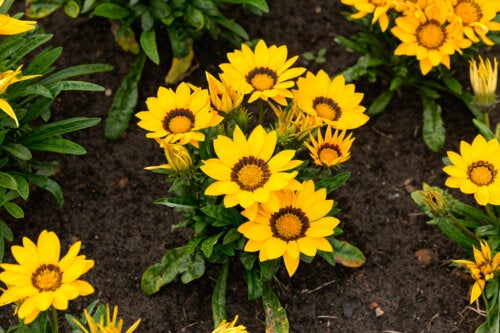Learn How to Care For Gazanias So They Bloom Longer
Belonging to the Asteraceae family, this plant of African origin captivates us by its wild appearance, similar to daisies. The attributes of gazanias allow them to be cataloged as an ornamental species of easy maintenance. If you’re just starting out growing them, don’t miss this article as we explain how to care for gazanias.
It’s important to clarify that the hardiness of these shrubs doesn’t refer to their appearance, but to their ability to adapt to almost any environment. Their “hardiness” doesn’t exempt them from receiving basic care to help them bloom longer.
It’s a matter of good watering, proper location, and nutrition accordingly. Without further ado, let’s get to the heart of the matter and find out how to care for gazanias.
Qualities of gazanias, a “sleepy” plant
Gazanias are a herb from which we can see small rosettes of hairy leaves emerging, which are lanceolate in shape and slightly whitish. It’s complemented by relatively large flowers, with yellow or orange ligule and petals in the same tones, as well as lilac, white, red, and pink.
It grows up to 30 centimeters (12 inches) tall, but there are also creeping ones, common in the creation of rock gardens. It’s a perennial plant that includes 79 species. The most common one is Gazania splendens.
After sunset, the flowers of Gazania splendens close their petals and open them again at dawn. Because of this spectacle of nature, they’re often called “sleepers”. They grow in urban environments, in the countryside, and even near the beach, due to their ability to tolerate different climates.
Learn more here: Best Tips to Keep Your Forget-Me-Not Plant Blooming
This is how to care for gazanias so they bloom longer
You shouldn’t leave your gazanias alone, even if they do need some independence to survive. Remember that the more attention you pay to a plant, the better it will bloom. Next, let’s see what care they need.
Good location
Gazanias aren’t demanding regarding space; they can be easily accommodated indoors or outdoors. The most important thing, however, is that the location guarantees them a good dose of sun.
The idea is that they can sense the light and open their petals in the daytime. When they’re left in the shade, the petals aren’t uncovered and the shrub produces fewer flowers.
Nourish the soil
An experiment published by Plant Archives analyzed the effect of potassium on vegetative and floral growth in Gazania species. The results revealed a significant increase in height, number of leaves, weight, and roots; in other words, supplying this mineral to the substrate would favor development.
Fertilizing them every 2 weeks, and providing organic matter, as well as compost or humus, are tips to extend the flowering time of this Asteraceae.
Using cuttings
The method to reproduce gazanias is by cuttings, which you take in autumn and prepare them over winter. Plant them in pots about 10 centimeters (4 inches) deep and moisten them until the plant stands upright.
Regulate climate excesses
This plant comes from southern Africa and is accustomed to extremely sunny environments. But if the gazanias in your garden show burned or damaged leaves, it’s advisable to move them to a semi-shaded area. Make a habit of checking the tips of the leaves, as this is where the plant begins to burn.
Read more here: Tips to Keep Your Crown of Thorns Blooming All Year Round
Dosing the water
The resistance of gazanias to arid climates prevents you from having to be constantly watering them. They appreciate hydration when the substrate is dry a little below the surface.
To find out, insert a wooden stick or a finger, at least up to 5 centimeters (2 inches); if the stem becomes dry then it’s time to water it. Failure to do so causes waterlogging and increases the likelihood of plant rot. Schedule watering every 2 weeks in summer if you’re using cuttings of the plant.
In gardens, sprinkler irrigation works.
Gazanias aren’t immune: you must protect them from pests
Insects and pests give no respite to plants, including gazanias. Generally, this species is vulnerable to parasites that can cause leaf spots or fungus.
Powdery mildew is one of the elements that attacks gazania. The University of Illinois Gardening Extension explains that this disease affects herbaceous and woody plants, with the appearance of a kind of white powder on stems, leaves, and flowers.
Natural insecticides are helpful in getting rid of the fungus in its early stages, but if the infection is advanced, the plant’s health is unlikely to be restored. The appropriate way to prevent or act quickly is to check them from time to time, in order to notice if there are changes in appearance.
What you should remember when trying to care for gazanias
In summary, caring for gazanias so they bloom longer involves placing them where the sun gives them, but without allowing the sun to burn them, providing vitamins to the substrate and controlling the water supply in order not to waterlog them.
As last recommendations, prune the parts that are in bad condition and remove fallen leaves and petals from the pot or planting area. If they carry any pests, these will damage the substrate. Cutting the weeds that surround the plant is another infallible resource to boost the nutrition and energy that gazanias require in their flowering.
All cited sources were thoroughly reviewed by our team to ensure their quality, reliability, currency, and validity. The bibliography of this article was considered reliable and of academic or scientific accuracy.
- Al-Rubaye, B. C. H., & Khudair, T. Y. (2020). The effect of fertilization with boron and potassium on some natural and flowering traits of the gazania plant. Plant Archives, 20, 140–144. https://www.mendeley.com/catalogue/9e986deb-cb36-3320-85b4-af2fd76cc2d1/
- Enfoque: plantas y enfermedades. Milidu polvoriento. Enfoque: plantas enfermedades. Extensión de Jardinería de la Universidad de Ilinois. https://web.extension.illinois.edu/focus_sp/pm.cfm
- Herbario Virtual del Mediterráneo Occidental. Gazania rigens (L.) Gaertner. Herbario Virtual del Mediterráneo Occidental. http://herbarivirtual.uib.es/es/general/1209/especie/gazania-rigens-l-gaertner
